The Seeker of Sanctuaries
By Nusrat Khawaja | Art Line | Published 6 years ago
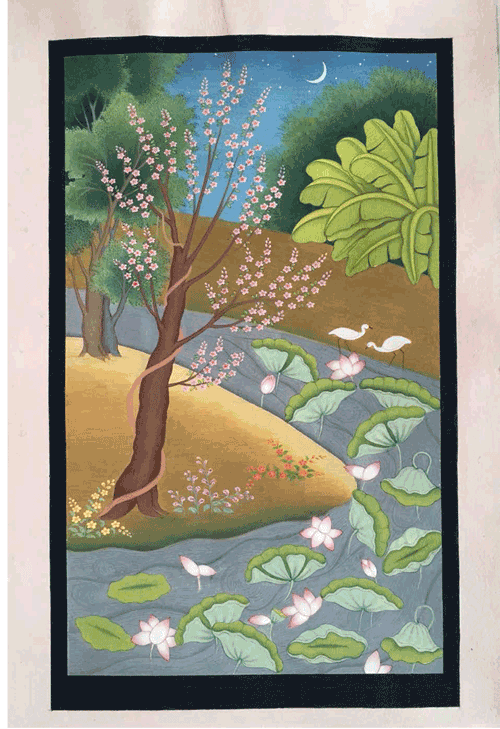
While the Moon Rose
The enchantment of Pahari miniature painting flourishes under the exquisite hand of Susana Marin. In her solo show at Koel Gallery, titled One Source, Many Forms; A Journey into the Visual Languages of the Sub-Continent, demonstrates her mastery of two different visual languages, that of geometrical pattern and of Pahari devotional painting:
Pahari painting flourished from the 17th to 19th centuries. Rulers in the hill states, from Jammu to Garhwal, patronised artists who drifted away from Mughal courts into the hills of north-west India. Patronage led to the creation of families of artists (through which the Pahari style proliferated) such as that of Pandit Seu of Guler, the father of Manaku and the notable Nainsukh.
With the demise of royalty in the modern state of India, patronage-dependent arts have been set back considerably and Pahari painting is no exception. Adherents such as Susana Marin offer hope for the vitalisation of links to traditional knowledge of techniques. Susana’s journey to the source of the visual language of miniature painting is an intriguing one.
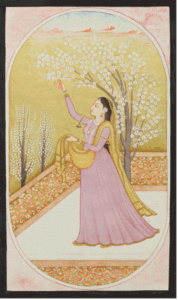
Padmini Nayika
Susana was born in Madrid and she drew and painted from the time she was seven years old. She frequently painted with her father who was also an artist. She owes her love for drawing to his emphasis on drawing as a fundamental skill for painters. Susana also had an aptitude for music and she trained as a concert pianist. Clearly, she does not believe in half measures. Painting, however, has completely taken over Susana’s time in recent years.
She came under the spell of Pahari painting through a chance encounter with an illustrated copy of the Gita Govinda at a friend’s home. Within the pages of the book, the mythical landscapes of idealised nature, depicted in the Kangra style, attracted her deeply. Susana’s desire to express her hand in this style took her to India in search of a teacher. After considerable frustration, a series of chance encounters connected her with the revivalist Kangra Arts Promotion Society in Dharamshala, Himachal Pradesh, where she found guidance to develop her skill.
Hearing Susana talk about her search and subsequent proficiency in the art of Pahari painting gives many insights into the history and context of this traditional art from the Himalayan foothills.
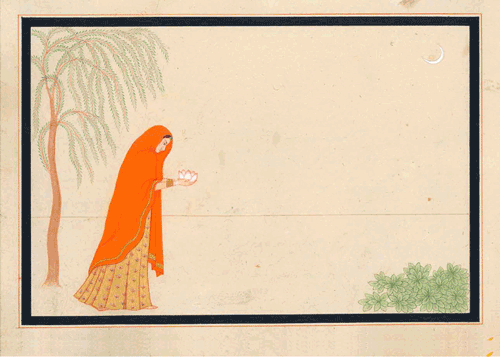
She speaks of the textual foundations for Pahari illustrations. Devotional texts such as the Gita Govinda, Bhagavata Purana and folk ballads dedicated to the worship of Krishna were translated into imagery, permeated with myth and pastoral sensibility. She explains that Pahari texts were inscribed on the back of paintings themselves and are, therefore, hidden from view in framed works.
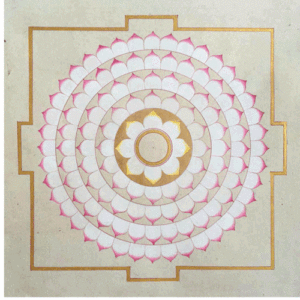
Heart Lotus
As an artist trained in European drawing techniques, Susana had to override the proportions of human —and particularly facial — anatomy that shehad internalised. She adopted a two-pronged approach. She copied works by known masters, thereby treating the artworks as de facto gurus. She analysed proportions by measurement. She discovered they followed formulae established in canonical texts such as the Vishnudharmottara Purana. Susana emphasises that the analytical process was her own path to understanding a tradition that was unfamiliar, yet so captivating. Traditional teaching methods would have relied on apprenticeship and transmission or shruti.
Susana is diligent about adhering to traditional material. She sources handmade vasli paper from Ustads Muhammad and Zakir Hussain Kagzi in Sangameer. Early Pahari painting, she explains, was sourced from Sialkot where the finest vasli used to be made.
The source materials for miniature painting are a munificence of Mother Earth. For the colours, the sheen came from metals such as gold, silver and tin, whereas colours were created by grinding mineral and organic pigments such as cinnabar, madder, orpiment, indigo, malachite, etc. Historically, the women of artists’ families prepared the paint. Susana prepares the pigments herself. She speaks of an almost metaphysical process of purification in the hours of grinding. She does not separate the craft of preparation from the skill of drawing and painting a miniature. It is a creative continuum which gives her art such authenticity. She has used cinnabar, indigo and madder as base paints for her geometrical series. This series investigates the aniconic geometric patterns such as in Mughal patterns and yantra symbolism. The range of pigments is much wider for Pahari painting.
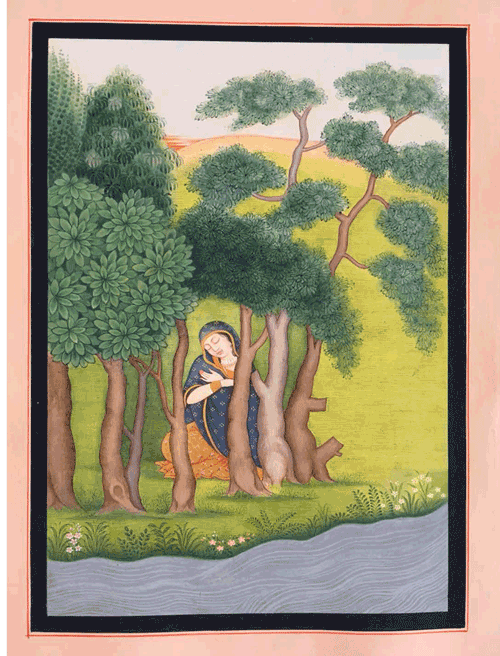
Recollection
A question arises whether the potential for innovation exists in traditional art practice, particularly when revivalism is essential to its continuity. Susana concedes there is a fine balance between authenticity and innovation. She believes mastery of principles precedes innovation, although scope for compositional rearrangements and illustrations from texts exists. She has created several of her own compositions and played with minimising the scenic background in paintings such as ‘Offering’ and ‘Reverence,’ a deviation practiced by Nainsukh as well.
Susana Marin’s evolution as an artist is testimony to the power of affinity. Pahari iconography — depicting nature as sanctuary and the archetypal spiritual seeker as female — has been adhered to faithfully. Joyousness permeates this mythical sanctuary. The Himalayan foothills remain verdant under her brush.


